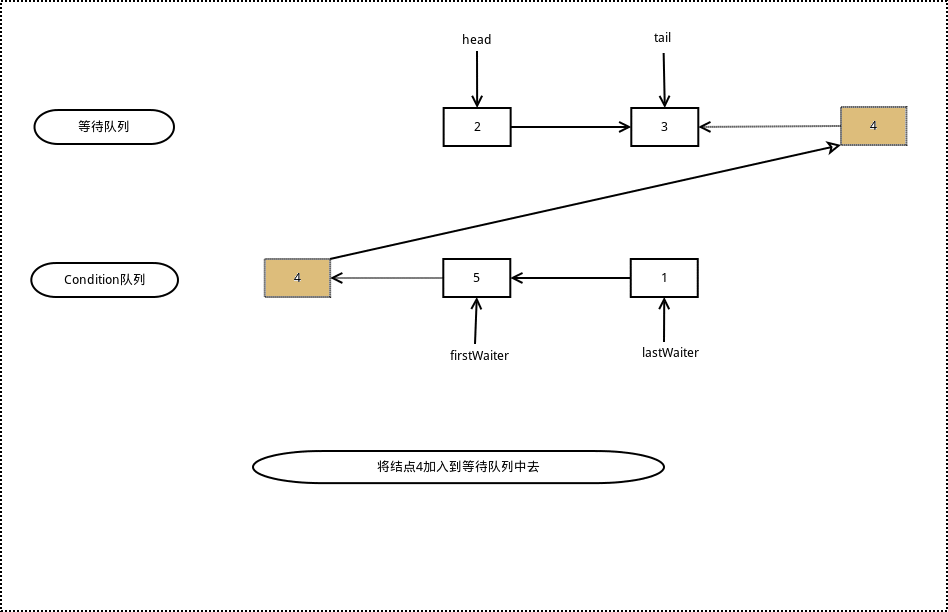Java 并发编程 J.U.C 之 Condition
此篇文章是作者两年前发布在黄金档的文章。
在上一篇中,我们了解了下 J.U.C 的锁的获取与释放的过程,这个过程主要通过在 A.Q.S 中维持一个等待队列来实现,其中我们也提到了,在 A.Q.S 中除了一个等待队列之外,还有一个 Condition 队列,在了解 Condition 队列之前,先来看一下 Condition 是怎么回事:
The synchronizer framework provides a ConditionObject class for use by synchronizers that maintain exclusive synchronization and conform to the Lock interface. Any number of condition objects may be attached to a lock object, providing classic monitor-style await, signal, and signalAll operations, including those with timeouts, along with some inspection and monitoring methods.
上面的这一段内容摘自 Doug Lea 的 AQS 论文,从上面这一段话可以看出,Condition 主要是为了在 J.U.C 框架中提供和 Java 传统的监视器风格的 wait,notify 和 notifyAll 方法类似的功能,那么先来解释一下这三个方法的作用:
- Object.wait() 方法:使当前线程释放 Object 上的监视器并且挂起,直到有另外的线程调用 Object.notify() 方法或者 Object.notifyAll() 方法唤醒当前线程,当被唤醒后,Object.wait() 方法会尝试重新获取监视器,成功获取后继续往下执行。注意 Object.wait() 方法只有在当前线程持有 Object 的监视器的时候才能够调用,不然会抛出异常。
- Object.notify() 方法:用于唤醒另外一个调用了 Object.wait() 方法的线程,如果有多个都调用了 Object.wait() 方法,那么就会选择一个线程去 notify(),具体选择哪一个和具体的实现有关,当前线程在调用 Object.notify() 方法以后会就释放Object的监视器,和 wait() 方法一样,Object.notify() 方法只有在当前线程持有 Object 的监视器的时候才能够调用,不然就会抛出异常。
- Object.notifyAll() 方法:唤醒所有调用了 Object.wait() 方法的线程,如果有多个线程调用了 Object.wait() 方法,那么就会引发这些线程之间的竞争,最后谁成功获取到 Object 的监视器和具体的实现有关,当前线程在调用 Object.notifyAll() 方法以后会就释放 Object 的监视器,和 wait() 方法一样,Object.notifyAll() 方法只有在当前线程只有 Object 的监视器的时候才能够调用,不然就会抛出异常。
那么 Condition 是如何实现 wait,notify 和 notifyAll 方法的功能呢?我们接下来看:
在 Condition 中,wait,notify 和 notifyAll 方法分别对应了 await,signal 和 signalAll 方法,当然 Condition 也提供了超时的、不可被中断的 await() 方法,不过我们主要还是看一看 await,notify 和 notifyAll 的实现,先看 await:
await 方法
public final void await() throws InterruptedException {
if (Thread.interrupted())
throw new InterruptedException();
Node node = addConditionWaiter();
int savedState = fullyRelease(node);
int interruptMode = 0;
while (!isOnSyncQueue(node)) {
LockSupport.park(this);
if ((interruptMode = checkInterruptWhileWaiting(node)) != 0)
break;
}
if (acquireQueued(node, savedState) && interruptMode != THROW_IE)
interruptMode = REINTERRUPT;
if (node.nextWaiter != null)
unlinkCancelledWaiters();
if (interruptMode != 0)
reportInterruptAfterWait(interruptMode);
}
整个 await 的过程如下:
- 在第 2 行处,如果当前线程被中断,则抛出中断异常。
- 在第 4 行处,将节点加入到 Condition 队列中去,这里如果 lastWaiter 是 cancel 状态,那么会把它踢出 Condition 队列。
- 在第 5 行处,调用 tryRelease,释放当前线程的锁
- 在第 7 行处,判断节点是否在等待队列中(signal 操作会将 Node 从 Condition 队列中拿出并且放入到等待队列中去),如果不在等待队列中了,就 park 当前线程,如果在,就退出循环,这个时候如果被中断,那么就退出循环
- 在第 12 行处,这个时候线程已经被 signal() 或者 signalAll() 操作给唤醒了,退出了 4 中的 while 循环,尝试再次获取锁,调用 acquireQueued 方法。
可以看到,这个 await 的操作过程和 Object.wait() 方法是一样,只不过 await() 采用了 Condition 队列的方式实现了 Object.wait() 的功能。
signal 和 signalAll 方法
在了解了 await 方法的实现以后,signal 和 signalAll 方法的实现就相对简单了,先看看 signal 方法:
public final void signal() {
if (!isHeldExclusively())
throw new IllegalMonitorStateException();
Node first = firstWaiter;
if (first != null)
doSignal(first);
}
这里先判断当前线程是否持有锁,如果没有持有,则抛出异常,然后判断整个 condition 队列是否为空,不为空则调用 doSignal 方法来唤醒线程,看看 doSignal 方法都干了一些什么:
private void doSignal(Node first) {
do {
if ( (firstWaiter = first.nextWaiter) == null)
lastWaiter = null;
first.nextWaiter = null;
} while (!transferForSignal(first) &&
(first = firstWaiter) != null);
}
这个 while 循环的作用就是将 firstWaiter 往 Condition 队列的后面移一位,并且唤醒 first,看看 while 循环中 tranferForSignal:
final boolean transferForSignal(Node node) {
/*
* If cannot change waitStatus, the node has been cancelled.
*/
if (!compareAndSetWaitStatus(node, Node.CONDITION, 0))
return false;
/*
* Splice onto queue and try to set waitStatus of predecessor to
* indicate that thread is (probably) waiting. If cancelled or
* attempt to set waitStatus fails, wake up to resync (in which
* case the waitStatus can be transiently and harmlessly wrong).
*/
Node p = enq(node);
int c = p.waitStatus;
if (c > 0 || !compareAndSetWaitStatus(p, c, Node.SIGNAL))
LockSupport.unpark(node.thread);
return true;
}
这段代码的作用就是修改 Node 的 waitStatus 为 0,然后将 Node 插入到等待队列中,并且唤醒 Node。
signalAll 和 signal 方法类似,主要的不同在于它不是调用 doSignal 方法,而是调用 doSignalAll 方法:
private void doSignalAll(Node first) {
lastWaiter = firstWaiter = null;
do {
Node next = first.nextWaiter;
first.nextWaiter = null;
transferForSignal(first);
first = next;
} while (first != null);
}
这个方法就相当于把 Condition 队列中的所有 Node 全部取出插入到等待队列中去。
总结
在了解了 await,signal 和 signalAll 方法的实现以后,我们再来通过一副 gif 动画来看一看这一个整体的过程:
